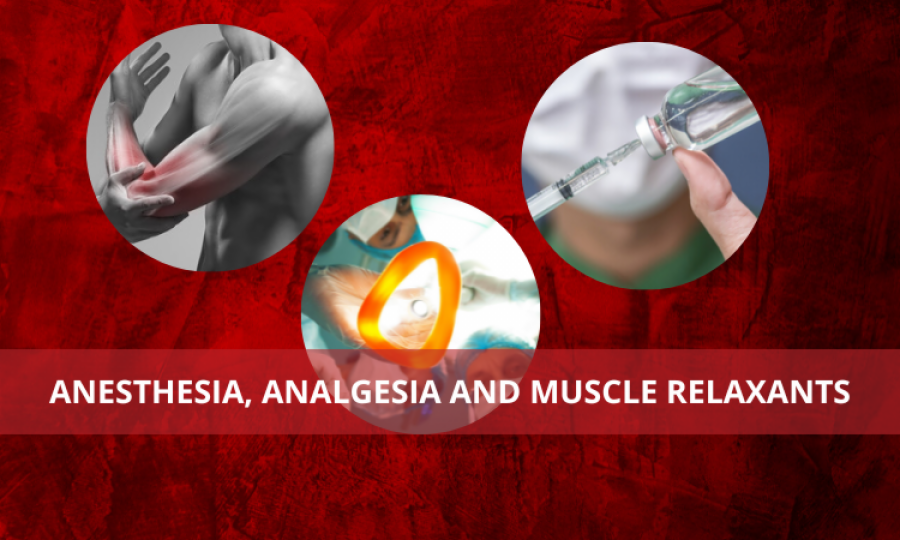Anesthesia, Analgesia and Muscle Relaxants

Analgesia is the relief of pain without losing consciousness. Analgesics are drugs like Aspirin, Carprofen, etc. Whereas, Anesthesia is the loss of physical sensation independent of consciousness. Anesthetic drugs are Ketamine, Sevoflurane, Propofol, Isoflurane, etc. Muscle relaxants block the nerve impulses to the muscles. They are also referred to as neuromuscular blocking agents. They are three different mechanisms producing different results. During surgeries, when a patient is unconscious, a combination of anesthesia, analgesia and muscle relaxants is used to relax the patient completely.
Anesthesia
There are multiple types of anesthetic drugs—local anesthetics, general anesthesia, inhalational anesthesia etc. Anesthesia is associated with some degree of analgesia but not vice versa. These delivery systems depend upon the need of the patient. Local anesthetics are medications that block the conduction of nerve impulses. They are also known as "numbing agents". These drugs can be injected or sprayed in a small region to block sensation from a localized area. Some local anesthetics are benzocaine spray and lidocaine ointment. General anesthetics are medications that induce and maintain a state of unconsciousness. This state also causes anterograde amnesia. They are used in long-duration operative procedures and can be administered intravenously or inhaled. Inhalational gases are Sevoflurane, Desflurane, and Isoflurane. They require rigorous pre-operative clearance and a monitored environment. Local anesthetics are generally deemed safer than general anesthetics.
Muscle Relaxants
They are also called Paralytics. In general surgery, they are used to aid in intubation etc. Succinylcholine and Vecuronium are muscle relaxants used during short and lengthy procedures. These drugs are long and short-acting ones. These drugs weaken the body's voluntary muscles and help in smooth operational procedures. Previously when muscle relaxants weren't known, a large amount of anesthesia was used during surgeries to stop the patient's voluntary actions, which was hazardous to the patient. For example, during eye surgeries, a muscle relaxant can be used to relax the eye muscles.
Analgesia
Analgesic drugs provide pain relief. Anesthesiologists used Acetaminophen, NSAIDs, and Narcotics to provide analgesia during surgery. Routes of delivery can be IV, IM, oral or transdermal. Analgesics are also used post-operatively to relieve pain and ensure fast healing and recovery. Common oral painkillers like NSAIDs and paracetamol are available over the counter to relieve conditions like toothache, headache, menstrual pain, and traumatic pain. Care must be taken to not go overboard with these nonprescription drugs as they also come with many side effects. The most common side effects are gastric discomfort, renal dysfunction, dependence and bowel disturbance.
A combination of drugs, such as analgesics, anesthetics and muscle relaxants, are co administered to achieve the desired state of surgical anesthesia. These are important for several reasons, such as reducing morbidity, ensuring optimal surgical environment, preventing complications and improving quality of life. Proper care must be taken before clearing a patient for general anesthesia. Anesthesiologists are trained to clear and monitor the patient during operative procedures. Hence, an experienced anesthesiologist must always be on board to prevent any mishaps regarding optimal anesthesia.
Advertisement
Trending
Popular
Aging: New study identifies key lifestyle, environmental factors ...
-
Hair loss: Discovery uncovers key stem ...
08:00 PM, 25 Feb, 2025 -
Broccoli sprout compound may help lower ...
11:31 AM, 25 Feb, 2025 -
Gas Pain vs. Heart Attack: How to tell ...
09:00 PM, 22 Feb, 2025 -
Coconut oil supplement shows promise ...
08:00 PM, 20 Feb, 2025



